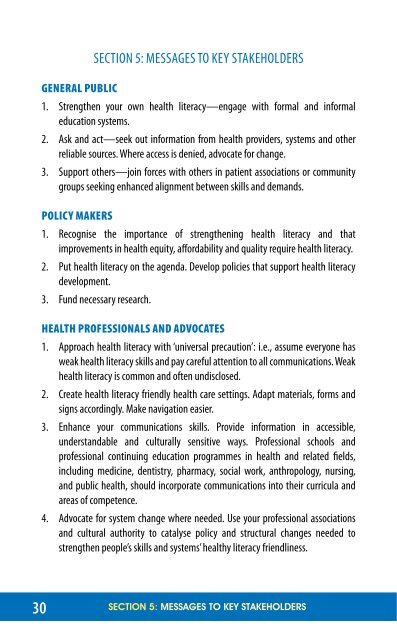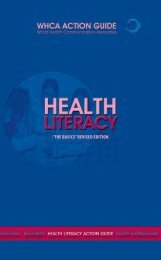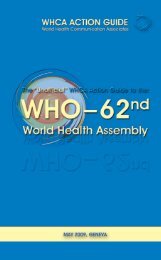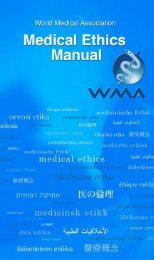Part 1 'the basics' - World Health Communication Associates
Part 1 'the basics' - World Health Communication Associates
Part 1 'the basics' - World Health Communication Associates
Create successful ePaper yourself
Turn your PDF publications into a flip-book with our unique Google optimized e-Paper software.
30<br />
general Public<br />
SECTION 5: MESSAGES TO KEy STAKEHOLDERS<br />
1. Strengthen your own health literacy—engage with formal and informal<br />
education systems.<br />
2. Ask and act—seek out information from health providers, systems and other<br />
reliable sources. Where access is denied, advocate for change.<br />
3. Support others—join forces with others in patient associations or community<br />
groups seeking enhanced alignment between skills and demands.<br />
Policy makers<br />
1. Recognise the importance of strengthening health literacy and that<br />
2.<br />
improvements in health equity, affordability and quality require health literacy.<br />
Put health literacy on the agenda. Develop policies that support health literacy<br />
development.<br />
3. Fund necessary research.<br />
health Professionals and advocates<br />
1. Approach health literacy with ‘universal precaution’: i.e., assume everyone has<br />
weak health literacy skills and pay careful attention to all communications. Weak<br />
health literacy is common and often undisclosed.<br />
2. Create health literacy friendly health care settings. Adapt materials, forms and<br />
signs accordingly. Make navigation easier.<br />
3. Enhance your communications skills. Provide information in accessible,<br />
understandable and culturally sensitive ways. Professional schools and<br />
professional continuing education programmes in health and related fields,<br />
including medicine, dentistry, pharmacy, social work, anthropology, nursing,<br />
and public health, should incorporate communications into their curricula and<br />
areas of competence.<br />
4. Advocate for system change where needed. Use your professional associations<br />
and cultural authority to catalyse policy and structural changes needed to<br />
strengthen people’s skills and systems’ healthy literacy friendliness.<br />
Section Section 5: meSSaGeS to key StakeHolderS






